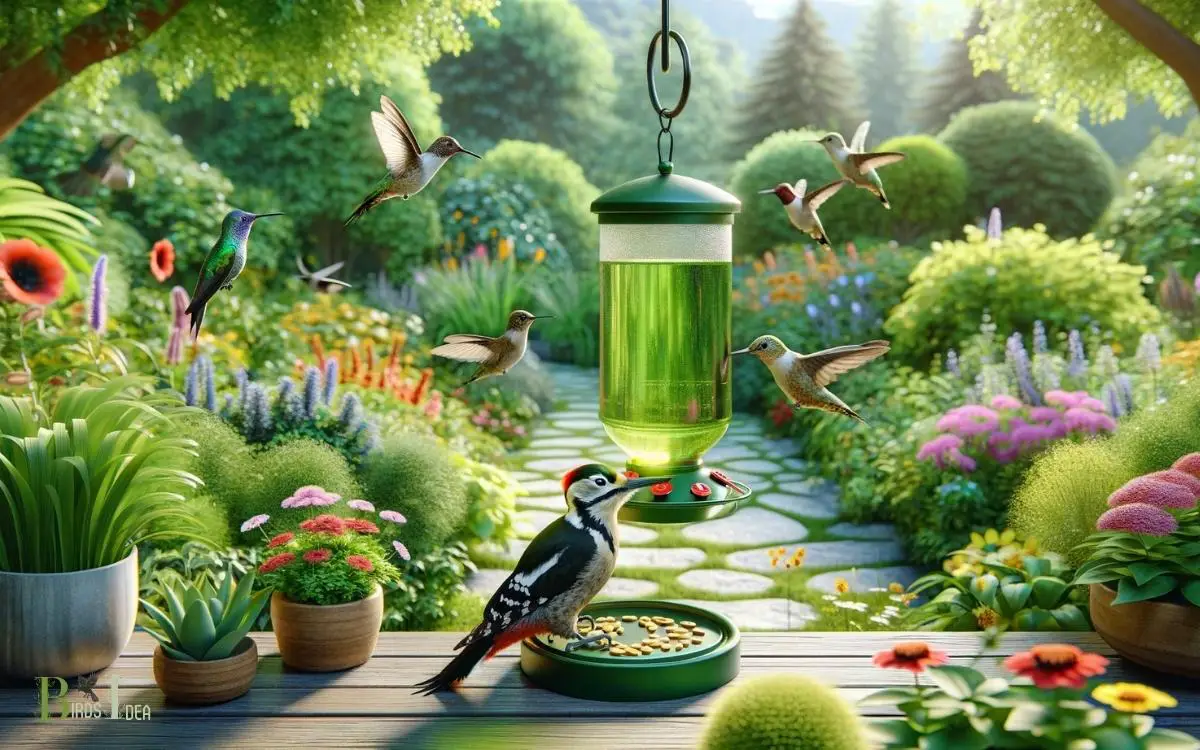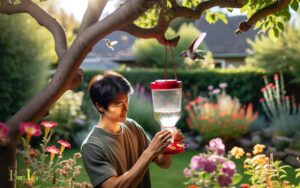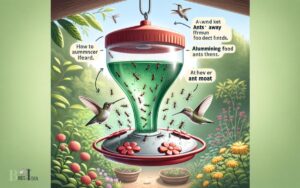Do Woodpeckers Eat Hummingbird Food? Yes!
Yes, woodpeckers may occasionally eat hummingbird food, particularly the sugar water from hummingbird feeders.
While their primary diet consists of insects, sap, nuts, and fruit, some woodpecker species have adapted to utilizing bird feeders, including those intended for hummingbirds.
Woodpeckers are known to be opportunistic feeders and have diverse diets that can include:
The presence of woodpeckers at hummingbird feeders is not uncommon. They are attracted to the high-calorie sugar solution, which provides a quick and easy energy source.
However, their size and feeding behavior can deter hummingbirds and potentially damage the feeders.
To enjoy a peaceful coexistence between woodpeckers and hummingbirds, consider using feeder designs that discourage woodpecker access while still welcoming the smaller hummingbirds.

Key Takeaway
Woodpecker Feeding Behavior
The woodpecker’s feeding behavior is characterized by its specialized diet and foraging techniques.
Their unique zygodactyl feet, with two toes pointing forward and two toes pointing backward, provide a strong grip on tree trunks and branches while they forage.
This specialized foot structure, combined with a stiff tail for support, allows woodpeckers to cling to vertical surfaces and move around tree trunks with ease.
Their feeding behavior is a testament to their adaptability and specialized anatomical features for foraging.
Woodpecker Diet Preferences
Understanding woodpecker diet preferences is crucial for conservation efforts, as it helps in providing suitable habitats and managing ecosystems effectively.
- Insects: Woodpeckers feed on various insects such as beetles, ants, caterpillars, and insect larvae.
- Fruits: They also consume a variety of fruits, especially during the non-breeding season.
- Nuts: Woodpeckers have been observed feeding on nuts, providing them with essential nutrients.
- Sap: Some woodpecker species have been known to consume sap from trees, especially during the winter months.
Potential Interactions
Exploration of Circumstances Where Woodpeckers Might Encounter Hummingbird Food
- Feeder Proximity: Woodpeckers may encounter hummingbird food when feeders are situated near their natural habitat, prompting exploration.
- Attracted by Sound: The audible hummingbird feeding activity might attract woodpeckers to investigate and potentially sample the food source.
- Resource Competition: In areas with limited food sources, woodpeckers may inadvertently encounter hummingbird food, leading to unexpected interactions.
Examination of Woodpeckers’ Adaptability to Diverse Food Sources
- Generalist Diets: Woodpeckers, often opportunistic feeders, can adapt to diverse food sources, including nectar, insects, and fruits.
- Seasonal Changes: During scarcity, woodpeckers may explore alternative food, potentially leading them to hummingbird feeders.
- Learning Behavior: Observations suggest that some woodpecker species may learn to associate hummingbird feeders with a supplemental food source.
In understanding these interactions, it becomes crucial to implement effective deterrent strategies to maintain a harmonious environment for both woodpeckers and hummingbirds.
Hummingbird Feeder Intrusion
When considering the issue of hummingbird feeder intrusion, it is important to explore feeder protection methods and woodpecker deterrent options.
Feeder protection methods may include physical barriers or specialized feeders designed to limit access to specific bird species.
Various deterrent options, such as visual deterrents or sound devices, can be effective in deterring woodpeckers from accessing hummingbird feeders.
Feeder Protection Methods
One effective way to prevent hummingbird feeder intrusion by woodpeckers is to use physical barriers.
These barriers can help deter woodpeckers from accessing the hummingbird feeder, ensuring that the nectar is solely available to the intended hummingbird visitors.
Here are some effective feeder protection methods:
- Wire Mesh: Surround the hummingbird feeder with wire mesh that has small openings, preventing woodpeckers from reaching the nectar ports.
- Baffle: Install a baffle above the feeder to block the woodpeckers’ access from the top.
- Spiky Deterrents: Attach spiky strips or deterrents on the feeder’s perches to discourage woodpeckers from landing.
- Visual Deterrents: Hang shiny objects or use reflective tape near the feeder to visually deter woodpeckers.
These methods can help maintain a peaceful and undisturbed feeding environment for hummingbirds.
Woodpecker Deterrent Options
To address the issue of woodpecker intrusion at hummingbird feeders, it is essential to consider effective deterrent options that can safeguard the nectar for the intended hummingbird visitors.
Various deterrent options can be employed to prevent woodpeckers from accessing the hummingbird feeders.
These options aim to create an environment that is unappealing or inaccessible to woodpeckers, thus preserving the nectar for hummingbirds.
Below is a table outlining potential woodpecker deterrent options for hummingbird feeders:
| Deterrent Options | Description | Effectiveness |
|---|---|---|
| Reflective Tape | Shiny, reflective tape to deter woodpeckers | Moderate |
| Baffles | Install baffles above or below the feeder | High |
| Spacing | Ensure feeders are placed away from structures | High |
Nectar Vs. Insects
During the spring and summer months, woodpeckers may opt to consume nectar as an alternative food source to insects.
Nectar provides woodpeckers with a rich source of energy, particularly during breeding and nesting seasons when their energy demands are higher.
While woodpeckers are primarily insectivorous, they will supplement their diet with nectar from flowers, sap wells, or hummingbird feeders.
The consumption of nectar by woodpeckers varies among species, and some woodpecker species are more likely to feed on nectar than others.
Nectar consumption is especially common among species like the Lewis’s Woodpecker and the Red-headed Woodpecker.
This dietary flexibility allows woodpeckers to adapt to changing environmental conditions and food availability.
Understanding woodpeckers’ dietary flexibility sheds light on the impact of feeder placement on their feeding behavior.
Feeder Placement Impact
Feeder placement significantly influences the accessibility of nectar to woodpeckers, impacting their feeding behavior and dietary choices.
The following factors illustrate the impact of feeder placement on woodpeckers’ access to hummingbird food:
- Height: Placing feeders at varying heights can affect the woodpeckers’ ability to access the nectar, with higher feeders potentially deterring them.
- Distance from Trees: Proximity to trees can influence woodpeckers’ feeding patterns, as they may feel more secure feeding closer to potential escape routes.
- Visibility: Feeders that are easily visible to woodpeckers may attract them, while those that are obstructed by obstacles may be less appealing.
- Surrounding Environment: Feeders placed in open areas may make woodpeckers feel vulnerable, impacting their willingness to feed.
Understanding these factors can help in strategizing feeder placement to attract or deter woodpeckers from feeding on hummingbird food.
Do Raccoons and Woodpeckers Compete for Hummingbird Food?
Raccoons’ appetite for hummingbird food might make them potential competitors to woodpeckers. These sneaky mammals are known to raid bird feeders and can easily consume the nectar meant for these delicate birds. Woodpeckers, on the other hand, primarily rely on insects found inside tree bark, but they occasionally enjoy a sip of sweet nectar too. Ultimately, both species might encounter each other when they cross paths at a hummingbird feeder.
Coexisting With Woodpeckers
To effectively coexist with woodpeckers, understanding the behavior and biology of these birds is essential in developing harmonious solutions.
Woodpeckers play a crucial role in the ecosystem, and it’s important to find ways to peacefully share space with them.
Here are some strategies for coexisting with woodpeckers:
- Provide alternative food sources such as suet feeders and nuts to divert their attention from damaging structures.
- Use visual deterrents like reflective tape or wind chimes to discourage woodpeckers from pecking on buildings.
- Repair any existing damage to structures promptly to prevent woodpeckers from establishing pecking territories.
- Consider installing nest boxes to provide alternative nesting sites for woodpeckers, reducing the likelihood of them damaging buildings.
Conclusion
Despite the common belief that woodpeckers do not consume nectar from hummingbird feeders, their feeding behavior and diet preferences suggest otherwise.
While deterrent strategies may be implemented to minimize feeder intrusion, it is important to recognize that woodpeckers are adaptable and resourceful birds.
Coexisting with these avian species requires a balance between providing suitable feeding opportunities and managing potential conflicts.
Ultimately, the irony lies in the cohabitation of two seemingly disparate avian species within the same feeding environment.






